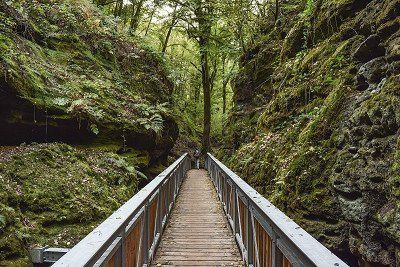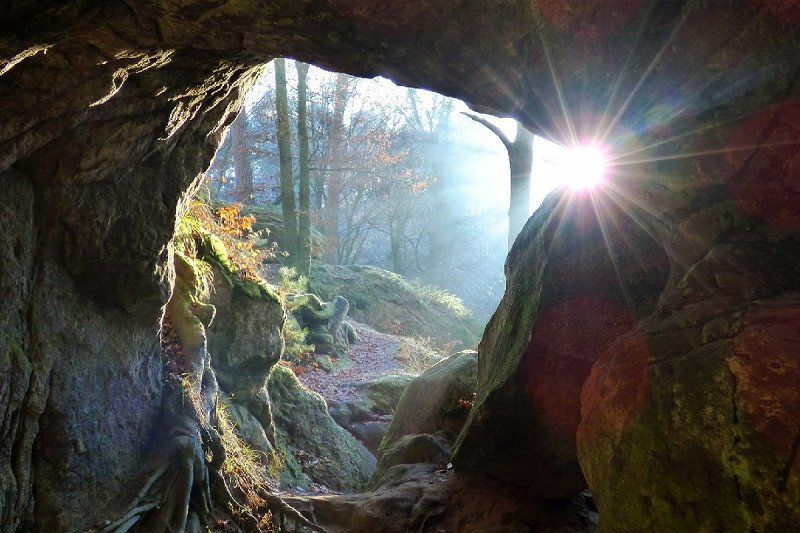Despite its small size, the Mullerthal region in Luxembourg is large enough for an array of outdoor activities, nature experiences, cultural sights and also has a great camping infrastructure – perfect for anyone who wants to experience as much as possible during their motorhome trip or camping holiday without having to drive a lot. Freeontour has put together a selection of places to visit and things to do in this region, which is also known as Little Switzerland.
Where exactly is the Mullerthal region?
The Mullerthal region is located in the northeast of the Grand Duchy of Luxembourg, north of Luxembourg City. This tourist region borders Germany to the east and is home to the towns of Echternach, Berdorf, Grundhof, Consdorf, Beaufort and Mullerthal. The largest city in the region is Echternach, which is on the border with Germany and very close to the German town of Trier.

What makes the Mullerthal region so special?
The Mullerthal region – or Mëllerdall in Luxembourgish – is often referred to as Luxembourg's Little Switzerland due to its landscape, which is home to a unique biotope interspersed with sandstone rocks. Its peculiar geological appearance is the result of thousands of years of erosion by the rivers Sauer and Black Ernz. Its terrain is so unique that the Natur- & Geopark Mëllerdall was added to the international network of UNESCO Global Geoparks in 2022. Criss-crossing this landscape of rocks and streams is the Mullerthal Trail, a long-distance hiking trail stretching 112 km with three loops. The Mullerthal region is not only popular with hikers, but is also a fantastic area for rock climbers, mountain bikers and cyclists per se. In short, if you're into rock formations, then this is the place to visit.
When is the best time to go camping in the Mullerthal region?
Most campsites in the Mullerthal are open between March/April and October/November; some campsites can even be visited all year round. Since wild camping is not permitted anywhere in Luxembourg – especially in natural areas such as the Mullerthal region – spring, summer and autumn are perfect for a camping trip. What's great is that even when it's hot in summer, you can hike and cycle here and then cool off in the deciduous forests and gorges of the region.
Our tip for a sustainable and environmentally friendly camping trip
Luxembourg is the first country in the world that has made all local public transport free of charge for everyone, regardless of whether you're a Luxembourg resident or tourist. There's usually a bus stop near most campsites in the Mullerthal region, so you can simply leave your vehicle at the campsite and explore the region by bus and/or bike as it's also free to take a bike, provided that there is enough space in the bus.
Please note: some of the campsites in the Mullerthal region are above the valley, others by the rivers Sauer and Black Ernz. A few campsites that are right by the water were severely affected by the flooding in the summer of 2021, some of which still can only be used to a limited extent or not at all. If you choose a riverside campsite, make sure that you contact the operator in advance to find out what the current situation is.

Stop #1: Echternach – the oldest town in Luxembourg
Echternach is not only the largest city in the Mullerthal region, it is also the gateway to the region when coming from Central Europe as well as the oldest town in Luxembourg. Several monumental buildings still bear witness to its history, such as the Roman palace from the 1st to 5th centuries, the parish church of St Peter and Paul built on a Roman fort with Merovingian, Romanesque and Gothic architectural elements, the Romanesque basilica from the 11th century (rebuilt after the Second World War), the curtain walls and towers of the medieval town complex, an abbey complex, orangery, rococo pavilion and patrician houses from the 18th century. The historical buildings surrounded by winding streets contribute to the special charm of Echternach.
And should the weather not cooperate, there are a number of museums in Echternach waiting to be discovered, notably the museum housed in the vaulted cellars of the abbey built in 1727. You'll find high-quality facsimiles of manuscripts on display here, such as the Codex Aureus Epternacensis, which were once produced by the monks in the Echternach scriptorium. The abbey museum also gives an insight into the life and work of Willibrord, who is said to have founded the abbey in 698. The Dancing Procession, which is part of the Intangible UNESCO World Heritage Site, is held every Whit Tuesday in honour of Willibrord.

Stop #2: Circular hike through Gorges de Loup/Wolfsschlucht
If you stay at the Officiel campsite in Echternach, it will only take you a few minutes to walk to the start of the hiking trail that takes you to Wolfsschlucht – or Wollefsschlucht as it's known locally. And you should definitely go regardless of where you've set up camp as it's one of the most spectacular natural monuments in Luxembourg's Little Switzerland. The rock walls rise up to 50 metres all around you as well as up into the sky, revealing the structure and the layers of the Luxembourg sandstone. An obelisk-like spire called Cleopatra's Needle soars at the entrance of the gorge. Route #2 of the Mullerthal Trail crosses Gorges de Loup. The path is also the local E1 hiking trail and part of the NaturWanderPark delux: Felsenweg 1 tour.
Stop #3: Stroll around Perekop
Starting in Echternach, our tour goes towards Berdorf, although we recommend stopping over at Perekop – an impressive, roughly 40-metre high rock formation right on the CR364 between Echternach and Berdorf. There's also a car park that hikers can use, making it easier to stop and explore. Several steps will take you through a crevice to a hilltop, which reveals a stunning panoramic view over the forests of Mullerthal. However, there's one small disadvantage – since Perekop is so close to the road, it's also one of the most visited rock formations in the Mullerthal region. If you come during peak season, try and visit as early or as late in the day as possible. Or simply set out on a longer hike towards Berdorf from here.

Stop #4: Explore the rock labyrinths near Berdorf
If you prefer to drive on, head to the Camping Martbusch campsite in Berdorf or the large visitor car park just in front of the campsite. You can then walk to the rock labyrinths of Berdorf and go on a circular hike, turning left and right at will through the rocky world.
There's a vast selection of well-marked hiking trails that you can spend at least two days walking on and combining as you wish. You'll also come across caves and crevices that you can explore to your heart's content.

Raiberhiehl (The Thieves' Den) is especially popular in Berdorf. It lies on the B2 hiking trail (4.2 km) in Berdorf and is to be avoided if you are claustrophobic as at the beginning you'll practically have to crawl through the cave, and the steep stairs at the end will take you back to daylight. If you want to do a longer hike, you can also walk from Berdorf through the rocks towards Priedegtstull (The Pulpit). With its name referring to its appearance, this unique rock formation has created its very own small rock labyrinth that is worth exploring. However, since the Pulpit is just off the CR364, most tourists stop here by car and climb it via its stone and iron stairs.

Stop #5: Obligatory photo shoot at the Schiessentümpel
We continue our journey to Müllerthal, the small town that gave the entire region its name. However, if you're looking for peace and solitude in a natural setting, you should avoid this place or at least plan to stop here very early in the morning or late in the afternoon because this is where you'll find probably the most photographed motif in the Mullerthal region: the small sandstone bridge from 1879 over the Schiessentümpel. The Schiessentümpel – or Schéissendëmpel – is a small picturesque waterfall on the Black Ernz river, which shoots into three streams over a rock edge into a rock basin below. To get to the Schiessentümpel, you can use the car park between the village of Müllerthal and the junction at Breidweiler Bridge on the CR121. A prettier option is to go on a small circular hike from the Heringer Millen tourist centre via the local hiking trails (W6 & W7) and on to the tufa source. Incidentally, the tourist centre is located in a beautifully restored grain mill from the 17th century, which also houses a mill museum, a large mill wheel that is still working and an old wood-fired oven where mill bread is still baked by hand. There is also a small RV park in the immediate vicinity.

Stop #6: Short adventure hike near Consdorf
If you're travelling with children or like walking through caves and crevices, then you need to try this short hiking trail near Consdorf. Starting from the car park at Konsdreffer Millen, you'll have to use a torch at times on the roughly 2.8 km loop as you go through the crevices of Kuelscheier, Rittergang and Déiwepëtz, which are at times so narrow that two people can't walk next to or past each other. There's also a kind of adventure path around the pitch-dark Kuelscheier crevice that you should definitely explore, so plan more time for your visit. The advantage is that it's usually nowhere near as crowded here as at the Schiessentümpel waterfall in Müllerthal. The possible downside is that most kids usually want to climb the crevices more than once. By the way, if you feel uneasy in narrow crevices, you can bypass these sections on the forest paths.

Stop #7: Visit the medieval Beaufort Castle
After exploring the Rittergang rock formation near Consdorf, you can visit Beaufort Castle, which was built in four construction periods between 1015 and 1650 and has Romanesque, Gothic and Renaissance architectural elements. Beaufort Castle was originally perched on a small rock peak towering about 23 metres above the valley floor. The castle was extended down the valley over the centuries so that parts of the outer bailey were surrounded by water. Some parts of the castle are still well preserved or have been rebuilt; others have been left as a ruin. Nevertheless, it's still worth visiting as you can look around the many rooms and vaults on your own. However, you can only visit the neighbouring 17th-century Renaissance castle on a guided tour. Its remarkable interior testifies to the magic of the past.
Our tip: the castle is located in a relatively narrow valley below Beaufort. The car park at the castle can get full very quickly in peak season, so it makes sense to either park your motorhome in a car park in Beaufort or to use the Camping Park Beaufort campsite from where it's just a short hike through the forest to get to the castle.




